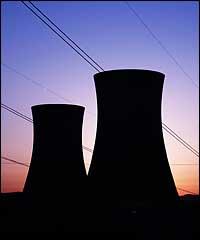
Sunday (March 28) marked the 25th anniversary of the Three Mile Island nuclear plant accident, and 25 years later the nation’s aging fleet of 103 reactors still face nagging questions about their ability to prevent mishaps.
These concerns, worsened by recent findings of massive corrosion at a nuclear power plant in Ohio, have so far kept utilities away from pursuing new nuclear plants for over two decades despite their potential to replace aging, air-polluting coal units.
In a bid to change that trend, the Bush administration has promoted incentives to build new nuclear plants. But the outlook is uncertain because a Republican-written energy bill with some of the administration’s proposals has long been stalled in the U.S. Senate.
On March 28, 1979, Walter Cronkite opened his nightly news broadcast for CBS television, calling the accident at the Pennsylvania plant “the first step in a nuclear nightmare.”
That was the first time that many Americans heard of the mishap, the most serious accident in U.S. nuclear history.
Early that morning, pumps feeding cooling water to the plant’s reactor failed, and 32,000 gallons of radioactive, superheated water spewed from a dodgy valve into the domed concrete reactor housing. Without water to cool them, over half of the reactor’s 36,000 nuclear fuel rods ruptured.
Government scientists said that the 636,000 people living within 20 miles of the plant got only minor radiation doses.
A string of mechanical failures and human errors caused the Three Mile Island accident after operators with Metropolitan Edison Co. switched off crucial equipment that could have lessened the severity of the partial meltdown.
The near-catastrophe at the plant, perched on an island in the Susquehanna River near Harrisburg, Penn., effectively halted any expansion in the U.S. nuclear energy industry, which generates about 20 percent of the nation’s electricity.
The resulting cancellation of dozens of planned nuclear plants forced utilities to rely on decades-old nuclear and coal-burning plants for growing electric power demands.
For the last decade, utilities have looked almost exclusively to natural gas plants to fill the gap, which has exacerbated the nation’s shortage of that clean-burning fuel.
And two years ago, massive corrosion found at an Ohio nuclear plant points to lingering safety questions.
“With plants aging and the number of checks dwindling, this is a troubling trend,” said David Lochbaum, a nuclear safety engineer with the Union of Concerned Scientists.
More at MSNBC Environmental News
No comments:
Post a Comment